BAMBOO JACKET
My sister-in-law found this gorgeous yarn on Marketplace and I couldn't resist making this jacket for her. I totally recommend this lovely bamboo blended yarn - its soft, easy to use and has a great fall.
In case you have just joined me, know that you can access all of my earlier creations by checking under ‘categories’ on the right hand side of this blog under “Labels”. Then, for your convenience, follow me here or on Facebook, You Tube, Pinterest, Twitter or Instagram.
Check out all my social media handles at the bottom of this blog
Oh, and may I add that the fastest way to find any of my blogs is via Pinterest.
All my blogs can be printed. Find the printer friendly (green) link on the right hand side of this blog. You can also hit Control P (or Command P for Mac) on your keyboard, and the blog will go directly to the connected printer.
Remember that you only print if absolutely essential. Save paper – Save Our Earth.
Do remember to add my blog URL when you make and show off your creation.
Just copy the link on the search bar above - that's the blog URL.
To purchase this or similar yarn online, click here to buy your yarns online via Amazon. While you will still pay the same, I may get paid by Amazon as well.
This is a free blog - so do pay it forward for me. Cheers.
Before we start, let's get a few calculations out of the way.
a) We need round bust, round waist and round hip measurements.
As always, please use the largest measurement for your calculations
b) We also need round armhole and sleeve length if you are making sleeves
c) We need depth of neckline for front & back if you are going to keep them at different lengths / heights
d) Finally as always I suggest you keep a well fitting top that you can use as a draft
e) With all my patterns, as you know, there is are several options and ideas offered, giving you lots of chance to be as unique and creative as you like. Enjoy.
We will be making five rectangles - one for the back ; two for the front and two for the sleeves. Easy enough. Let's start.
BACK : (Make one piece)
The stitch count for the back is in multiples of 3
Foundation Single Crochet : fsc : https://youtu.be/mcT85fwh4mA
Start Row 1 : with fsc in multiples of 3 for half the round waist measurement. Turn.
Row 2 : dc in the 1st fsc ;
(ch 1, sk next fsc , dc in the next fsc) ;
rep (to) till the end. Turn
Row 3 : dc in the 1st dc ;
(ch 1, dc in the next dc) ;
rep (to) till the end. Turn
Rep Row 3 till you reach the length you need for your top. The bottom row (where we started) is the base of the top and where you end will be the shoulders.
One rectangle for the back complete
FRONT : (Make two pieces)
The stitch count for the front is in multiples of 6
Foundation Single Crochet : fsc : https://youtu.be/mcT85fwh4mA
Start Row 1 : with fsc in multiples of 6 for half the front waist or 1/4th the round waist measurement. Turn.
Row 2 : dc in the 1st fsc ;
(ch 1, sk next fsc , dc in the next fsc) ;
rep (to) till the end ;
dc in the last dc. Turn
Notes : 1) In the following row we will sk a few dc and the ch-sps in between. I will only tell you about the dc skips as that is the obvious one.
2) If you are making this for a smaller size (S/M) you will start with lesser number of sts and then your *to* repeat may not be as many times as given. You can either work the *to* repeat once/twice and then work the (to) till end OR you can work *to* 3 as given and work (to) in any sts that remain.
Double crochet 2-tog : dc 2-tog : [yo, insert hk in st or ch-sp, yo and pull up a lp ; yo and draw through 2 lps] 2 times (3 lps on hk) ;
{yo, draw through 2 lps on hk} 2 times. One dc 2-tog made.
Today we work the dc 2-tog in the same stitch, to use it as a decorative stitch. Visit this video tutorial at https://youtu.be/lLUXOJ1sY9w
Row 3 : dc in the 1st 2 dc ;
(ch 1, dc in the next dc) ;
rep (to) once ;
*[ch 5, sk next 2 dc, dc 2-tog in the next dc] ;
ch 5, sk next 2 dc, dc in the next dc ;
rep (to) 2 times* ;
rep *to* 2 times ;
rep (to) till the end. Turn
Row 4 : dc in the 1st dc ;
(ch 1, dc in the next dc) ;
rep (to) till you reach the dc before the ch-5 sp ;
*[ch 5, sc on the dc 2-tog] ;
ch 5, dc in the next dc ;
rep (to) 2 times* ;
rep *to* till the end ;
dc in the last dc. Turn
Note : Remember that you repeat *to* and (to) as many times as you need to - or as you have worked in Row 3.
Row 5 : dc in the 1st 2 dc ;
(ch 1, dc in the next dc) ;
rep (to) once ;
*[ch 5, sc on the sc] ;
ch 5, dc in the next dc ;
rep (to) 2 times* ;
rep *to* 2 times ;
rep (to) till the end. Turn
Note : Remember that you repeat *to* and (to) as many times as you need to - or as you have worked in Row 5.
Row 6 : dc in the 1st dc ;
(ch 1, dc in the next dc) ;
rep (to) till you reach the dc before the ch-5 sp ;
*[ch 5, dc 2-tog on the sc] ;
ch 5, dc in the next dc ;
rep (to) 2 times* ;
rep *to* till the end ;
dc in the last dc. Turn
Row 7 : dc in the 1st 2 dc ;
(ch 1, dc in the next dc) ;
rep (to) once ;
*ch 1, dc in the ch-5 sp ;
[ch 1, dc in the same ch-5 sp]
ch 1 dc in the next dc 2-tog ;
ch 1, dc in the next ch-5 sp ;
rep [to] once ;
ch 1, dc in the next dc ;
rep (to) 2 times* ;
rep *to* 2 times ;
rep (to) till the end. Turn
Row 8 : dc in the 1st dc ;
(ch 1, dc in the next dc) ;
rep (to) till the end ;
dc in the last dc. Turn.
This completes one pattern repeat.
Rep Rows 3 - 8 till you reach the shoulders.
If you choose to shape front neckline, rep Rows 3 - 8, ending with Row 8 till the point you want to shape for neckline.
Note : If you want to shape for the front neckline, you will repeat the pattern only till that point. Please scroll down for the ideas given for neck shaping.
If you repeat to the shoulders, then you will get a small 'collar' like finish as the top centre parts of the jacket will 'flap open' after you join the shoulders.
Once you complete both front sections, please use one of these methods to join the front to the back.
Whipstitch to join : https://youtu.be/wZ-9LNzftMA
Invisible join : https://youtu.be/a6XZQ6VzJFM
Single crochet to join : https://youtu.be/6FXoW_47_dI
You will join sides from the base all the way till the point where you need to split for armhole, leaving an armhole opening.
For the armhole opening, you will measure from shoulders down the sides using half round armhole measurement.
You will then join the shoulders, leaving a neckline opening.
For the neckline opening, you first fold the back in half and find the centre point. Then using that centre point, mark 2 points on either side which will be half the neckline measure for back. The easiest way to figure this out will be to use a well fitting garment (not a stretch garment - regular cotton fabric garment works best). So say neckline for back is 8", then you will measure 4" on either side of that marked centre point. Got it?
Then work from the side of the shoulder till this marked point ; skip the neckline portion (say 8") in between and then join the other shoulder blade too.
Please note : As we have made a rectangle presentation, we will have a drop shoulder. This means that the shoulder attachment will be slightly off the shoulder and on the upper arm. You must remember this when you are working on the (length of) sleeve.
Neckline decrease ideas :
You have rep Rows 3 - 8 ending with Row 8 till you reach the point you're shaping for neckline at this point.
Note : As I am working on a slightly larger size, I've worked sl-st past the 1st 9 sts and then worked a dc 2-tog over the next 2 dc, skipping the ch-1 sp in between.
Instructions given below are for general use. Note that what you must figure is the width of the shoulder blade and the gap you need for the back neckline opening.
For the back neckline opening, fold garment in half and find centre. Then place 2 markers on either side that will determine the width (So say you want an 8" back neckline you will place markers at 4" on either side of the centre fold). You then decide width of shoulder (blades) and see that you get the front shoulder blade at the same point as that for the back. Easy enough, right? 😊
Decrease Row 1 : dc in the 1st dc ;
(ch 1, dc in the next dc) ;
rep (to) till the last 4 dc ;
dc 2-tog over the 5th and 4th last dc, skipping the ch-1 sp in between.
Turn. (Leave the last 3 dc unworked)
Decrease Row 2 : dc 2-tog over the 1st and 2nd dc, skipping the ch-1 sp in between ;
(ch 1, dc in the next dc) ;
ch 5, sk next 2 dc, dc in the next dc ;
rep (to) 2 times
*[ch 5, sk next 2 dc, dc 2-tog in the next dc] ;
ch 5, sk next 2 dc, dc in the next dc ;
rep (to) 2 times* ;
rep *to* once ;
rep (to) till the end. Turn
Decrease Row 3 : dc in the 1st dc ;
(ch 1, dc in the next dc) ;
rep (to) till you reach the dc before the ch-5 sp ;
*[ch 5, sc on the dc 2-tog] ;
ch 5, dc in the next dc ;
rep (to) 2 times* ;
rep *to* till the last 2 dc , just after working the last ch-5 ;
dc 2-tog over the last 2 dc, skipping the ch-1 sp in between.
dc in the last dc. Turn
Decrease Row 5 : dc in the 1st dc ;
ch 5, dc in the next dc ;
(ch 1, dc in the next dc) ;
rep (to) once ;
*[ch 5, sc on the sc] ;
ch 5, dc in the next dc ;
rep (to) 2 times* ;
rep *to* and then work rep of (to) till the end. Turn
We have a lovely curve for our neckline and here we stop our decreases.
We now continue in pattern till we reach the shoulders.
At the neckline end, we will end with ch-5 and dc in the last dc.
We start the following row in the same way at neckline end, with dc and then ch-5 and work the next pattern till the armhole end.
Notes : Remember that when you are following pattern we work 2 dc with ch-1 sps in between in the ch-5 sp. So when working this pattern and the ch-5 sp at the start, we work in the same way working ch-1 + dc twice in that starting ch-5 sp too.
Sleeve ideas :
The jacket works well with a short or pair of long sleeves but the method is the same for both.
Re-attach your yarn at the top (shoulder) centre or bottom of the armhole.
I chose to attach at the top shoulder.
I have also chosen to work 3 pattern repeats along the centre of the sleeve - so my centre top shoulder attachment worked well.
If you choose to make the same simple back pattern all through the sleeves, attach at the bottom of the armhole so that your attachment line is not seen.
If you are working the sleeve pattern : I started at the centre dc 2-tog of the pattern and then worked the ch-5 sp and then the (to) or (ch 1, dc in the next dc) part of the pattern ; I then worked one complete pattern ; then worked the (to) again till I was 10 dc (which includes all the ch-sps) from the end - at which point you work the spider-like pattern again ending with a ch-5 and join to the 1st dc 2-tog.
Yes, I know this sounds daunting but take it one stitch at a time and you will find it not so bad.
Once you get that first round done the rest is easier - trust me.
I ended with 2 rounds of hdc like I did for the full border of the jacket.
Border pattern :
I choose to work 2 rounds of hdc all around the base working continuously from base, up one side (front) , around the back neckline and down the other side (front) to finish at the base.
Note : 1) The base already has one row of fsc that we started with - so you may want to work a row of sc for the front and neckline too (to match)
2) Remember to work 3 hdc in each corner st (base of front and around neckline corners) to get a neat finish.
3) You could also end with a row of Crab Stitch or Reverse Single Crochet stitch : https://youtu.be/cG3crwyHPnk
How to make a loop for your button : https://youtu.be/oocVo-ZNIcM
If you're visiting me here for the first time, and have liked the experience, do add me to your mailing list (for your convenience) , and all my future free patterns will come straight to your mail box.
It is sad that though my blogs are very popular and being used by so many, not many think of giving credit when you post your projects on social media.
There is a lot of work that goes into writing one of these patterns, so do pay it forward – good karma and all that blah 😄


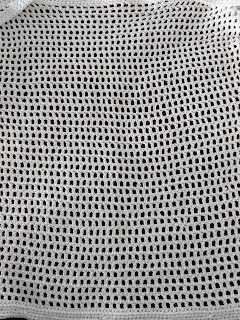


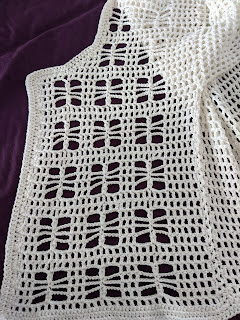


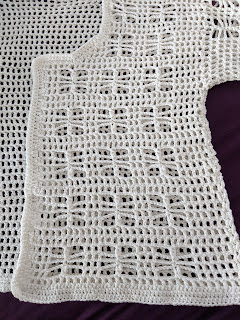



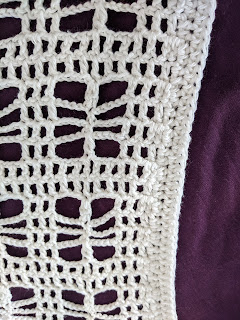
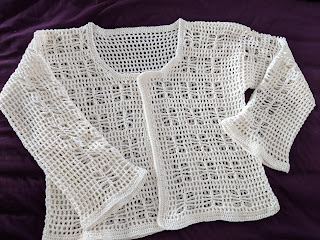
No comments:
Post a Comment
Thanks for taking the time to stop by. Do tell me what you think. Cheers